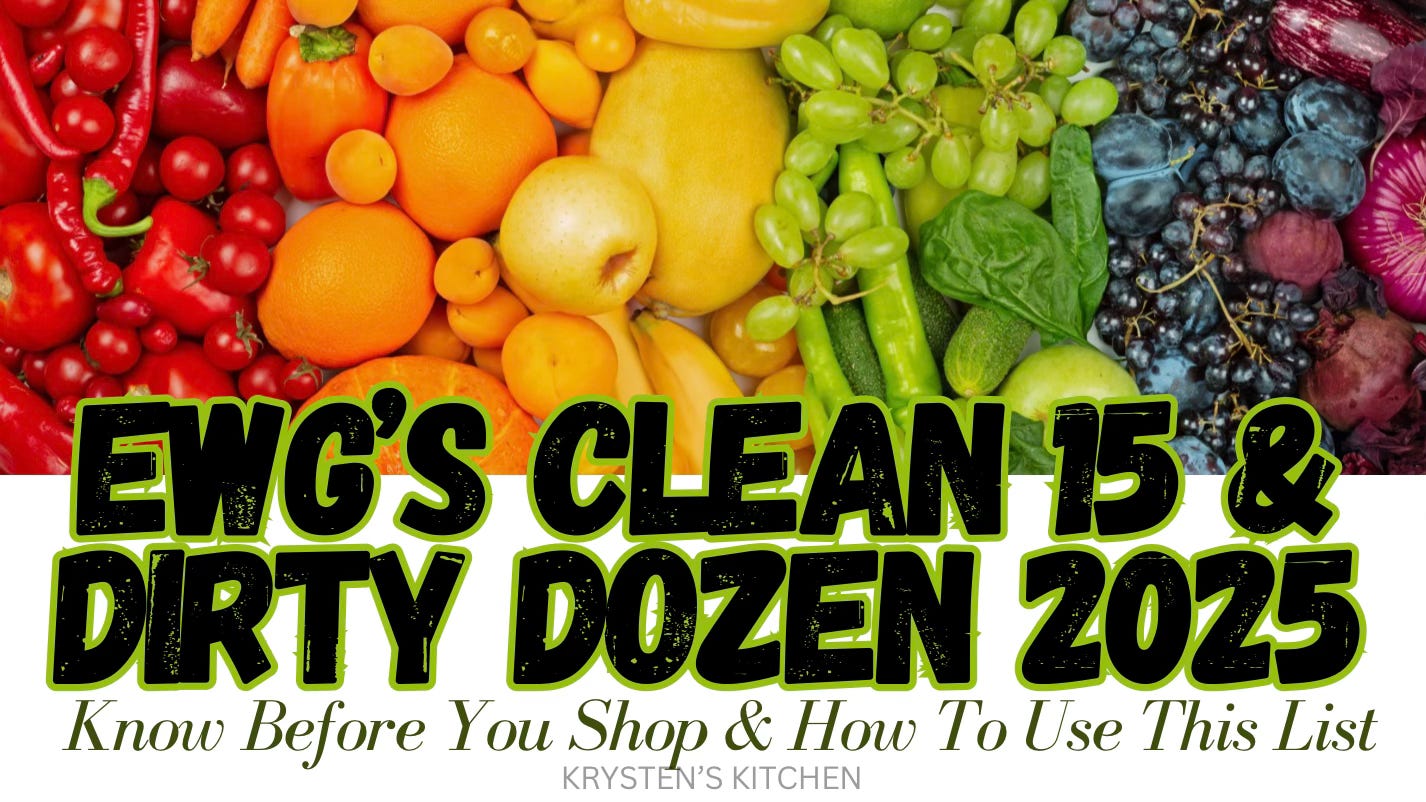EWG's Clean 15 & Dirty Dozen 2025
What You Need to Know Before You Shop & How To Use This List
I look forward to this list every year, the Environmental Working Group (EWG) releases the *Clean Fifteen* and *Dirty Dozen* lists—two essential guides to keep in your back pocket (literally) that helps you as the consumer navigate pesticide residues on fruits and vegetables. The 2025 update is here. Let’s get into it.
If you’re shopping at the farmers market or grocery store or even eating out (just something to think about) here’s what you should know this year.
Fruits and veggies are getting expensive (organic or not) and sometimes it’s not always realistic for families to purchase organic for everything. That’s where the *Clean Fifteen* and *Dirty Dozen* come in to play. These lists were created to help reduce your exposure and consumption of harmful pesticides—especially for growing children.
This year’s rankings are based on nearly 54,000 USDA tests across 47 types of produce, with all samples washed or peeled before testing—just as you’d do at home before making your favorite recipes (… from krystenskitchen.com — wink wink or my instagram feed… also wink wink)
For the first time, EWG evaluated not just the amount of pesticide residues found on produce, but also how toxic those pesticides actually are. This brings attention to chemicals that may linger in trace amounts but may have more serious long-term effects on health.
The 2025 Dirty Dozen (Highest Pesticide Residues) These are the fruits and vegetables that consistently tested highest in pesticide contamination—even after washing or peeling:
1. Strawberries
2. Spinach
3. Kale, collard & mustard greens
4. Grapes
5. Peaches
6. Pears
7. Nectarines
8. Apples
9. Bell & hot peppers
10. Cherries
11. Blueberries
12. Green beans
If you can, aim to buy these organic—especially if you’re feeding kids or pregnant women!
The 2025 Clean Fifteen (Lowest Pesticide Residues) These items tested cleanest, with nearly 60% showing no detectable pesticide residues at all:
1. Avocados
2. Sweet corn
3. Pineapples
4. Onions
5. Papayas
6. Sweet peas (frozen)
7. Asparagus
8. Honeydew melon
9. Kiwi
10. Cabbage
11. Watermelon
12. Mushrooms
13. Mangoes
14. Sweet potatoes
15. Carrots
These are great options to buy conventional if organic isn’t available or affordable.
Here’s how I use this list: I keep a note on my phone that has a list of the clean 15 and dirty dozen so that I can refer to my list easily it when I’m out and about
A Few Important Reminders when it comes to pesticides…
- The EPA considers many pesticides "safe"—until they’re not. Ingredients like chlorpyrifos and DCPA were once approved and are now banned or restricted due to health concerns.
- Washing helps… sort of - But it’s not perfect. While washing and peeling can reduce some pesticide exposure, they can’t eliminate it entirely. Still, always, always rinse your produce.
- Frozen produce counts. Don’t forget that frozen fruits and vegetables often retain nutrients well and may be more affordable and accessible than fresh options. There’s nothing wrong with buying frozen veggies but remember they still can contain pesticides.
- Eat produce! No matter how it’s grown, the most important thing is to add fruits and veggies to your diet. These lists are just tools and you can decide what you want to avoid and what you want to give grace on.
How to use these lists:
How you use this information is entirely up to you. You can follow it wholeheartedly and choose to not consume anything on the dirty dozen unless it’s organic. That’s fine. You could not care at all and eat what you want when you want it and call it a day. That’s okay too. Or you can figure out something in the middle that works for you and your family. That is also perfectly fine.
Here’s how I use it: I don’t purchase anything off the dirty dozen list unless it’s organic and I really only buy organic for our family. But — if I’m in a pinch and need an ingredient that’s not available in organics then I look at the dirty dozen list and if it’s on the list I opt out. If it’s off the list and it’s a necessity then I will purchase it. When eating out, we do what we can to avoid the dirty dozen list (especially for our toddler if we can) as much as possible.
Do what’s best for YOU and YOUR FAMILY!
The EWG’s Clean Fifteen and Dirty Dozen lists are not to scare you - they are just to inform you. Use them to make informed choices that fit your family’s needs and budget.
Thank you for subscribing to my channel and thank you to my paid subscribers as well. Please consider sharing this article or any of my other posts. Follow me on instagram and check out KrystensKitchen.com for amazing recipes. I have two cookbooks available here.






Might be a dumb question but, do you know if Appeal is on frozen items? I would assume not, since they’re frozen, but nothing surprises me anymore…